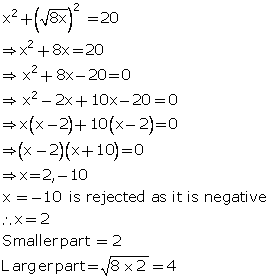The product of two consecutive integers is 56. Find the integers.
Let the two consecutive integers be x and x + 1.
From the given information,
x(x + 1) = 56
x2 + x - 56 = 0
(x + 8) (x - 7) = 0
x = -8 or 7
Thus, the required integers are - 8 and -7; 7 and 8.
Let the numbers be x and x + 1.
From the given information,
x2 + (x + 1)2 = 41
2x2 + 2x + 1 - 41 = 0
x2 + x - 20 = 0
(x + 5) (x - 4) = 0
x = -5, 4
But, -5 is not a natural number. So, x = 4.
Thus, the numbers are 4 and 5.
Let the two numbers be x and x + 5.
From the given information,
x2 + (x + 5)2 = 97
2x2 + 10x + 25 - 97 = 0
2x2 + 10x - 72 = 0
x2 + 5x - 36 = 0
(x + 9) (x - 4) = 0
x = -9 or 4
Since, -9 is not a natural number. So, x = 4.
Thus, the numbers are 4 and 9.
Let the numbers be x and ![]()
From the given information,

x = 4 ![]()
x = ![]()
![]() x = 4
x = 4
Thus, the numbers are 4 and ![]()
Let the numbers be x and x + 3.
From the given information,

Since, x is a natural number, so x = 2.
Thus, the numbers are 2 and 5.
Let the two parts be x and x - 15.

x = 5 ![]() One part = 5 and other part = 10
One part = 5 and other part = 10
x = 10 ![]() One part = 10 and other part = 5
One part = 10 and other part = 5
Thus, the required two parts are 5 and 10.
Let the two numbers be x and y, y being the bigger number. From the given information,
x2 + y2 = 208 ..... (i)
y2 = 18x ..... (ii)
From (i), we get y2=208 - x2. Putting this in (ii), we get,
208 - x2 = 18x
![]() x2 + 18x - 208 = 0
x2 + 18x - 208 = 0
![]() x2 + 26X - 8X - 208 = 0
x2 + 26X - 8X - 208 = 0
![]() x(x + 26) - 8(x + 26) = 0
x(x + 26) - 8(x + 26) = 0
![]() (x - 8)(x + 26) = 0
(x - 8)(x + 26) = 0
![]() x can't be a negative number , hence x = 8
x can't be a negative number , hence x = 8
![]() Putting x = 8 in (ii), we get y2 = 18 x 8=144
Putting x = 8 in (ii), we get y2 = 18 x 8=144
![]() y = 12, since y is a positive integer
y = 12, since y is a positive integer
Hence, the two numbers are 8 and 12.
Let the consecutive positive even numbers be x and x + 2.
From the given information,
x2 + (x + 2)2 = 52
2x2 + 4x + 4 = 52
2x2 + 4x - 48 = 0
x2 + 2x - 24 = 0
(x + 6) (x - 4) = 0
x = -6, 4
Since, the numbers are positive, so x = 4.
Thus, the numbers are 4 and 6.
Find two consecutive positive odd numbers, the sum of whose squares is 74.
Let the consecutive positive odd numbers be x and x + 2.
From the given information,
x2 + (x + 2)2 = 74
2x2 + 4x + 4 = 74
2x2 + 4x - 70 = 0
x2 + 2x - 35 = 0
(x + 7)(x - 5) = 0
x = -7, 5
Since, the numbers are positive, so, x = 5.
Thus, the numbers are 5 and 7.
Let the required fraction be![]() .
.
From the given information,

Thus, the required fraction is ![]() .
.
Let the numbers be 6x, 4x and 3x.
From the given information,
(6x)2 + (4x)2 + (3x)2 = 244
36x2 + 16x2 + 9x2 = 244
61x2 = 244
x2 = 4
x = ![]()
Since, the numbers are positive, so x = 2.
Thus, the numbers are 12, 8 and 6.
Let the two parts be x and y.
From the given information,
x + y = 20 ![]()
3x2 = (20 - x) + 10
3x2 = 30 - x
3x2 + x - 30 = 0
3x2 - 9x + 10x - 30 = 0
3x(x - 3) + 10(x - 3) = 0
(x - 3) (3x + 10) = 0
x = 3, ![]()
Since, x cannot be equal to![]() , so, x = 3.
, so, x = 3.
Thus, one part is 3 and other part is 20 - 3 = 17.
Assume the middle number to be x and form a quadratic equation satisfying the above statement. Hence; find the three numbers.
Let the numbers be x - 1, x and x + 1.
From the given information,
x2 = (x + 1)2 - (x - 1)2 + 60
x2 = x2 + 1 + 2x - x2 - 1 + 2x + 60
x2 = 4x + 60
x2 - 4x - 60 = 0
(x - 10) (x + 6) = 0
x = 10, -6
Since, x is a natural number, so x = 10.
Thus, the three numbers are 9, 10 and 11.
Let the numbers be p - 1, p and p + 1.
From the given information,
3(p + 1)2 = (p - 1)2 + p2 + 67
3p2 + 6p + 3 = p2 + 1 - 2p + p2 + 67
p2 + 8p - 65 = 0
(p + 13)(p - 5) = 0
p = -13, 5
Since, the numbers are positive so p cannot be equal to -13.
Thus, p = 5.
Work done by A in one day = ![]()
Work done by B in one day = ![]()
Together A and B can do the work in 15 days. Therefore, we have:

Since, x cannot be negative.
Thus, x = 24.
Let one pipe fill the cistern in x hours and the other fills it in (x - 3) hours.
Given that the two pipes together can fill the cistern in 6 hours 40 minutes, i.e., ![]()

If x =![]() , then x - 3 =
, then x - 3 =![]() , which is not possible.
, which is not possible.
So, x = 15.
Thus, one pipe fill the cistern in 15 hours and the other fills in (x - 3) = 15 - 3 = 12 hours.
Let the smaller part be x.
Then, (larger part)2 = 8x
\ larger part = ![]()
Now, the sum of the squares of both the terms is given to be 208

Thus, the required number is 2 + 4 = 6.
No comments:
Post a Comment